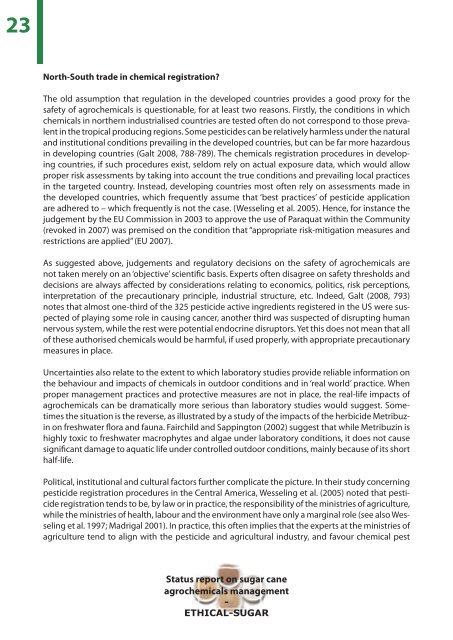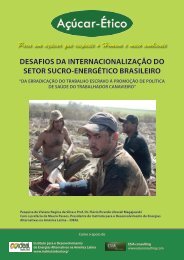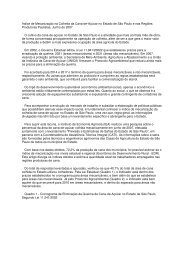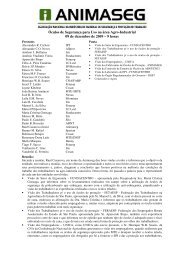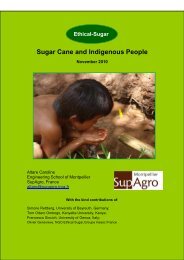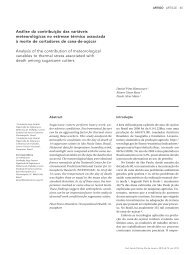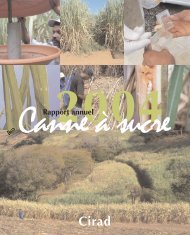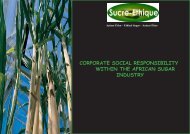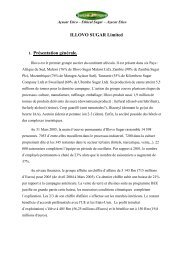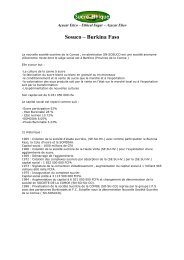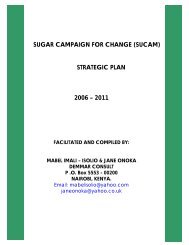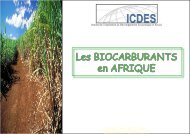Status report on sugar cane agrochemicals ... - Sucre Ethique
Status report on sugar cane agrochemicals ... - Sucre Ethique
Status report on sugar cane agrochemicals ... - Sucre Ethique
Create successful ePaper yourself
Turn your PDF publications into a flip-book with our unique Google optimized e-Paper software.
23<br />
North-South trade in chemical registrati<strong>on</strong>?<br />
The old assumpti<strong>on</strong> that regulati<strong>on</strong> in the developed countries provides a good proxy for the<br />
safety of <strong>agrochemicals</strong> is questi<strong>on</strong>able, for at least two reas<strong>on</strong>s. Firstly, the c<strong>on</strong>diti<strong>on</strong>s in which<br />
chemicals in northern industrialised countries are tested often do not corresp<strong>on</strong>d to those prevalent<br />
in the tropical producing regi<strong>on</strong>s. Some pesticides can be relatively harmless under the natural<br />
and instituti<strong>on</strong>al c<strong>on</strong>diti<strong>on</strong>s prevailing in the developed countries, but can be far more hazardous<br />
in developing countries (Galt 2008, 788-789). The chemicals registrati<strong>on</strong> procedures in developing<br />
countries, if such procedures exist, seldom rely <strong>on</strong> actual exposure data, which would allow<br />
proper risk assessments by taking into account the true c<strong>on</strong>diti<strong>on</strong>s and prevailing local practices<br />
in the targeted country. Instead, developing countries most often rely <strong>on</strong> assessments made in<br />
the developed countries, which frequently assume that ‘best practices’ of pesticide applicati<strong>on</strong><br />
are adhered to – which frequently is not the case. (Wesseling et al. 2005). Hence, for instance the<br />
judgement by the EU Commissi<strong>on</strong> in 2003 to approve the use of Paraquat within the Community<br />
(revoked in 2007) was premised <strong>on</strong> the c<strong>on</strong>diti<strong>on</strong> that “appropriate risk-mitigati<strong>on</strong> measures and<br />
restricti<strong>on</strong>s are applied” (EU 2007).<br />
As suggested above, judgements and regulatory decisi<strong>on</strong>s <strong>on</strong> the safety of <strong>agrochemicals</strong> are<br />
not taken merely <strong>on</strong> an ‘objective’ scienti� c basis. Experts often disagree <strong>on</strong> safety thresholds and<br />
decisi<strong>on</strong>s are always a� ected by c<strong>on</strong>siderati<strong>on</strong>s relating to ec<strong>on</strong>omics, politics, risk percepti<strong>on</strong>s,<br />
interpretati<strong>on</strong> of the precauti<strong>on</strong>ary principle, industrial structure, etc. Indeed, Galt (2008, 793)<br />
notes that almost <strong>on</strong>e-third of the 325 pesticide active ingredients registered in the US were suspected<br />
of playing some role in causing cancer, another third was suspected of disrupting human<br />
nervous system, while the rest were potential endocrine disruptors. Yet this does not mean that all<br />
of these authorised chemicals would be harmful, if used properly, with appropriate precauti<strong>on</strong>ary<br />
measures in place.<br />
Uncertainties also relate to the extent to which laboratory studies provide reliable informati<strong>on</strong> <strong>on</strong><br />
the behaviour and impacts of chemicals in outdoor c<strong>on</strong>diti<strong>on</strong>s and in ‘real world’ practice. When<br />
proper management practices and protective measures are not in place, the real-life impacts of<br />
<strong>agrochemicals</strong> can be dramatically more serious than laboratory studies would suggest. Sometimes<br />
the situati<strong>on</strong> is the reverse, as illustrated by a study of the impacts of the herbicide Metribuzin<br />
<strong>on</strong> freshwater � ora and fauna. Fairchild and Sappingt<strong>on</strong> (2002) suggest that while Metribuzin is<br />
highly toxic to freshwater macrophytes and algae under laboratory c<strong>on</strong>diti<strong>on</strong>s, it does not cause<br />
signi� cant damage to aquatic life under c<strong>on</strong>trolled outdoor c<strong>on</strong>diti<strong>on</strong>s, mainly because of its short<br />
half-life.<br />
Political, instituti<strong>on</strong>al and cultural factors further complicate the picture. In their study c<strong>on</strong>cerning<br />
pesticide registrati<strong>on</strong> procedures in the Central America, Wesseling et al. (2005) noted that pesticide<br />
registrati<strong>on</strong> tends to be, by law or in practice, the resp<strong>on</strong>sibility of the ministries of agriculture,<br />
while the ministries of health, labour and the envir<strong>on</strong>ment have <strong>on</strong>ly a marginal role (see also Wesseling<br />
et al. 1997; Madrigal 2001). In practice, this often implies that the experts at the ministries of<br />
agriculture tend to align with the pesticide and agricultural industry, and favour chemical pest<br />
<str<strong>on</strong>g>Status</str<strong>on</strong>g> <str<strong>on</strong>g>report</str<strong>on</strong>g> <strong>on</strong> <strong>sugar</strong> <strong>cane</strong><br />
<strong>agrochemicals</strong> management<br />
-<br />
ETHICAL-SUGAR


